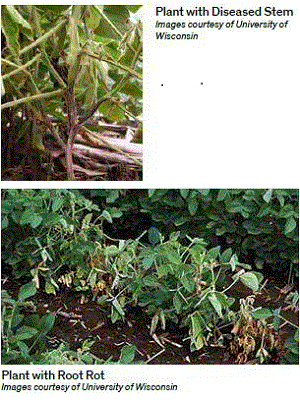WHAT IS PHYTOPHTHORA
Phytophthora root and stem rot are caused by the pathogen Phytophthora sojae and account for a large portion of yield loss every year. More than 50 different races of P. sojae have been identified. Phytophthora can attack soybean plants at any stage of development but is often most damaging when it occurs early in the season.
PATHOGEN BIOLOGY
This pathogen survives as thick-walled resting spores called oospores, which can persist for years in the soil. During periods of adequate soil moisture and temperature, oospores germinate to form structures called sporangia. When the soil becomes saturated, sporangia release small swimming spores called zoospores that are attracted to the soybean roots, where they attach and germinate. Phytophthora hyphae then invades the root and grows within the soybean root cells.
CONDITIONS FAVOURING THE DISEASE
Cool, wet weather favours disease development which means heavy clay soils, poorly drained areas and slowdrying areas of the field are most prone to disease. Reduced tillage and monoculture of soybeans may also increase the damage due to disease. A good time to look for symptoms is one to two weeks after heavy rains. The optimum temperature for disease development is 25- 30ºC.
PHYTOPHTHORA AFFECT ON PLANTS
If conditions are favourable for Phytophthora growth at the time of seeding or the days following seeding, you may notice that seeds fail to emerge or infected seedlings are killed shortly after emergence. Symptoms in young plants include rapid yellowing and wilting, accompanied by a soft rot and collapse of the root. Infected areas of the stem are water-soaked or “bruised” and disintegrate easily (soft rot). More mature plants infected by Phytophthora generally show reduced vigour and may be gradually killed as the growing season progresses. Foliar symptoms on older plants occur as general yellowing of the lower leaves then progress upward on the plant. This is followed by wilting and death. The root system is usually severely affected such that lateral and branch roots are almost completely discoloured. Tap roots show a brown discolouration on the surface and if split, the inner tissue shows a tan to brown discolouration. Perhaps the best diagnostic symptom of the disease on susceptible varieties is a lower stem discolouration that may extend several nodes up the stem.
MANAGEMENT OF PHYTOPHTHORA
Control of Phytophthora root rot requires a combination of the following four strategies:
1. Soybean Variety Selection: Soybean varieties with resistance or tolerance to Phytophthora root rot are available. Some varieties have both resistance and tolerance and provide the best control in fields where conditions favour Phytophthora. Within soybean variety selection you have two ways to manage Phytophthora - resistant and tolerant varieties.
• Resistant Varieties: A resistant variety is a soybean variety that contains one or more known Phytophthora resistance genes, usually referred to as ‘rps’ genes. The P. sojae fungus is present in soils as a series of races. Resistance in any one soybean variety is effective against some, but not all of the races. See chart below for a list of the seven Phytophthora resistance genes and what races of Phytophthora each gene provides resistance to. Root rot is controlled in a particular field when the variety grown is resistant to all of the Phytophthora races that happen to be present in that field. However, resistance will break down with the appearance of another race that the variety is not resistant to. If this occurs, switch to a variety that is resistant to the new race, use a tolerant variety or a different gene for resistance. Grow varieties with different resistance genes in rotation. To determine which races may be present in a field, plant strips of several varieties with known race resistance.
• Tolerant Varieties: Most soybean varieties are rated for their ‘tolerance’ to Phytophthora by exposing the plants to Phytophthora and rating the plants for damage. It is possible for a soybean variety to not have any of the known rps genes, yet still have good Phytophthora tolerance scores. Some disease develops in these varieties when grown in infested soils regardless of which races of Phytophthora are present. Yields of tolerant varieties are not usually seriously reduced by the disease. However; plants are not immune and under extremely favourable conditions for disease development, plant injury can occur.
2. Seed Treatment: Fungicide seed treatments can be used to reduce the early season damping off. A combination of seed treatment and genetic resistance provides one of the best options for limiting disease loss.
3. Good Soil Management:
• Improve soil drainage so that flooding is eliminated or minimized.
• Use cultural practices that improve soil structure, reduce soil compaction and improve drainage. Improving drainage is particularly important in no-till soils that retain moisture and require less precipitation to saturate the soil.
• Phytophthora zoospores are produced only in saturated soil. If soils are not saturated early in the season, varieties with partial resistance will escape disease and remain disease-free throughout the season.
4. Plant Management:
• Rotate with corn and wheat. More soybeans in the rotation will result in a higher Phytophthora population and an increase in the number of races present in the field.
• Plant when soil temperatures are above 13°C. • Inspect each soybean field for dead plants in late July or early August to determine whether the variety has enough.
• Inspect each soybean field for dead plants in late July or early August to determine whether the variety has enough.

If you have any questions of concerns about Phytophthora and how it can affect your field, please contact Holly at hloucas@dow.com or ask a question on Twitter @HollyLoucas.